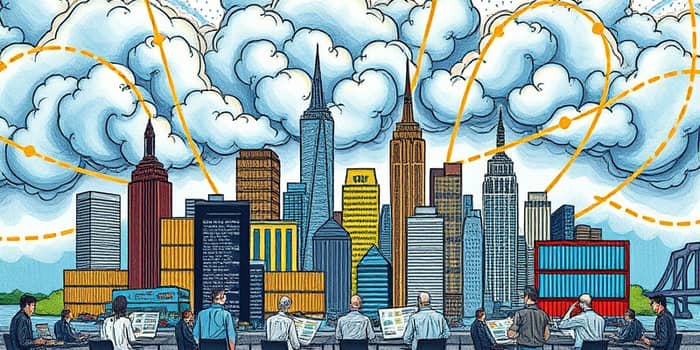In a world where downturns emerge unexpectedly, preparing for the next economic upheaval is more important than ever. From global pandemics to financial crises and natural disasters, communities and enterprises require robust strategies to endure and flourish. This article offers a comprehensive roadmap for building resilience at both macro and micro levels, combining policy insights, organizational tactics, case evidence, and emerging technological tools to create a stronger, more adaptable future.
Introduction: The Need for Economic Resilience
Economic shocks can quickly erode growth, employment, and social stability when left unaddressed. Regions that invest in agility, resourcefulness, and innovation discover that downturns become opportunities to strengthen foundations rather than mere setbacks.
By learning to anticipate, absorb, and adapt to shocks, leaders unlock the potential to navigate uncertainty with confidence. This proactive mindset reshapes challenges into catalysts for progress.
Understanding Economic Shocks: Causes and History
Economic shocks have punctuated history from the Great Depression of the 1930s to the financial crisis of 2008. Supply chain breakdowns, cyberattacks, trade disputes, and extreme weather events have all triggered cascading effects around the globe.
During the COVID-19 pandemic, widespread lockdowns and cross-border disruptions revealed the fragility of interconnected markets. In the United States alone, supply chain interruptions contributed to an estimated $1.4 trillion loss in output during 2020. Recognizing the many faces of shocks is the first step toward resilience.
Macro-Level Strategies for Community Resilience
Communities and policymakers deploy two complementary approaches: steady-state initiatives that reinforce long-term stability, and responsive actions that accelerate recovery after crises.
- Promote industrial diversification for stability across the community economy.
- Implement workforce upskilling and reskilling programs to adapt labor markets.
- Engage stakeholders in comprehensive resilience planning to build consensus.
- Invest in redundant communication and utilities infrastructure to prevent failures.
- Use GIS and analytics for rapid assessments post-crisis.
- Preserve natural buffers against environmental disasters through smart land-use.
Steady-state programs, such as career transition initiatives and sustainable development practices, bolster communities before disruptions occur. When a shock strikes, targeted recovery funds, expedited permitting, and business retention networks speed revival.
Business and Organizational Tactics for Survival
At the organizational scale, agility and preparedness often determine whether a firm survives a downturn or succumbs to mounting pressures. Implementing structured risk management and financial safeguards is essential for continuity.
- Reduce reliance on single sectors through multiple revenue streams.
- Establish relationships with multiple suppliers to mitigate risks.
- Maintain at least six months of reserves for unplanned expenses.
- Conduct regular scenario analysis and stress testing to prepare for downturns.
- Leverage automation and data-driven insights for strategic advantage.
Developing a resilient organizational culture promotes ongoing reassessment, flexibility, and innovation. Regular budget reviews, insurance coverage audits, and consultation with legal and financial experts ensure that playbooks are ready when disruptions occur.
Key Metrics and Case Evidence
Data-driven benchmarks help track progress and inform adjustments to resilience strategies. Two widely recognized metrics include recommended cash reserves and the impact of diversification on recovery speed.
Companies with diversified supply chains and revenue sources consistently bounce back approximately 30% faster from economic downturns. This compelling evidence underscores the value of spreading risk across markets and channels.
Tools, Resources, and Emerging Trends
Technology plays a pivotal role in modern resilience frameworks. Automation streamlines operations, freeing teams to focus on strategy and innovation. Advanced analytics reveal demand patterns, loss triggers, and emerging threats before they escalate.
Geospatial Information Systems (GIS) empower local governments and businesses to visualize vulnerabilities, track economic churn, and prioritize recovery efforts based on real-time data. Meanwhile, digital marketing and e-commerce platforms provide alternative revenue channels, helping firms pivot rapidly during physical disruptions.
Artificial intelligence and machine learning are poised to enhance scenario planning by simulating complex shock scenarios, allowing stakeholders to refine response plans and resource allocations proactively.
Conclusion: Building a Resilient Future
Resilience is not a static endpoint but an ongoing journey that demands vigilance, collaboration, and a willingness to learn from every challenge. By integrating proactive preparation and rapid response at every level, societies and organizations can chart a course toward a stable, thriving future.
As emerging risks evolve—from cyber threats to climate shocks—stakeholders must remain united in their commitment to adaptability. Through continuous innovation, stakeholder engagement, and strategic investment, we can transform uncertainty into opportunity and ensure that the next generation inherits an economy built to withstand whatever comes next.
References
- https://onemoneyway.com/en/blog/economic-resilience/
- https://www.lga.cpa/insights/blog/2025-is-your-business-ready-to-thrive/
- https://www.cohnreznick.com/insights/build-resilience-uncertain-times-key-business-strategies
- https://www.eda.gov/resources/comprehensive-economic-development-strategy/content/economic-resilience
- https://theceoviews.com/strategies-for-smbs-building-economic-resilience/
- https://agn.org/insight/resilience-strategies-for-businesses-navigate-economic-uncertainty/










